Hair loss is more common than most people think, and it’s no longer something you have to simply live with. Thanks to advanced techniques and top-notch clinics, hair transplant in Dubai (زراعة الشعر في دبي) has become a trusted solution for restoring natural hair growth. Whether you’re in the early stages of hair thinning or dealing with bald patches, a hair transplant might be the answer you’ve been searching for.
In this article, we’ll break down the most important facts you need to know before deciding if this procedure is right for you.
What Is a Hair Transplant?
A hair transplant is a surgical procedure that involves moving hair follicles from a donor area (typically the back or sides of the scalp) to thinning or balding areas. It’s a long-term solution that uses your own hair, so the results look natural and are usually permanent.
Why Choose Dubai for Hair Transplant?
Dubai has earned a strong reputation as a medical tourism hotspot. Here’s why:
1. Advanced Clinics and Technology
Dubai’s aesthetic clinics are equipped with state-of-the-art technology and follow global standards.
2. Skilled Surgeons
Hair transplant specialists in Dubai often have international qualifications and years of experience.
3. Medical Tourism-Friendly Services
With English-speaking staff, customized packages, and luxury recovery options, the city caters perfectly to international clients.
Types of Hair Transplant Procedures in Dubai
There are two main techniques available:
1. Follicular Unit Extraction (FUE)
This is the most popular method. Hair follicles are extracted one by one and implanted into the target area. It leaves minimal scarring and has a quicker recovery time.
2. Follicular Unit Transplantation (FUT)
Also known as the strip method, this technique involves removing a strip of scalp from the donor area. It may leave a linear scar but is often used when a higher number of grafts is needed.
Some clinics also offer robotic-assisted transplants and Sapphire FUE, which are even more precise and minimally invasive.
Who Is an Ideal Candidate?
Not everyone qualifies for a hair transplant. Here’s what makes someone a good fit:
-
Sufficient donor hair on the sides or back of the scalp
-
Good general health
-
Realistic expectations
-
Hair loss that has stabilized (not rapidly progressing)
If you’re too young or suffering from a medical condition that causes hair loss, your surgeon may advise waiting or exploring alternative treatments like PRP therapy.
How Much Does Hair Transplant in Dubai Cost?
The cost varies depending on the technique used, the number of grafts needed, and the clinic you choose. On average:
-
FUE transplant: AED 10,000 to AED 20,000
-
FUT transplant: AED 8,000 to AED 15,000
-
Per graft rate: AED 10 to AED 20 per graft
Many clinics offer free consultations and custom pricing based on individual needs.
What Is the Procedure Like?
Here’s a step-by-step look at what happens during a typical hair transplant in Dubai:
1. Consultation
A surgeon evaluates your hair loss, discusses expectations, and recommends the best approach.
2. Preparation
Your scalp is shaved and cleaned. Local anesthesia is applied to numb the area.
3. Extraction
Follicles are harvested from the donor area using FUE or FUT methods.
4. Implantation
The extracted follicles are strategically placed in the balding areas to match your natural hairline.
5. Post-Procedure Care
You’ll receive aftercare instructions, medications, and follow-up appointments to ensure proper healing.
What Is the Recovery Process?
Recovery is generally smooth:
-
Day 1–3: Mild swelling and redness
-
Day 4–10: Scabs form and start to fall off
-
Week 2–4: Transplanted hair may shed (normal part of the process)
-
Month 3–4: New hair growth begins
-
Month 6: Noticeable results
-
Month 12: Final results fully visible
Most people return to work within a few days, especially after FUE procedures.
Are the Results Permanent?
Yes, the transplanted hair is typically permanent. The follicles are taken from areas that are genetically resistant to balding, so they continue to grow normally in the new location.
However, surrounding non-transplanted hair may still thin over time, which is why some patients opt for follow-up treatments or maintenance procedures.
Common Myths About Hair Transplant in Dubai
Let’s bust a few common myths:
Myth 1: Only men get hair transplants.
Fact: Women with hair thinning or receding hairlines are also candidates.
Myth 2: The results look fake.
Fact: Modern techniques ensure natural-looking outcomes.
Myth 3: It’s painful and takes forever to recover.
Fact: The procedure is minimally invasive and recovery is relatively quick.
Myth 4: The results are immediate.
Fact: It takes several months for new hair to grow in and fully mature.
Tips for Choosing the Right Clinic in Dubai
If you’re serious about getting a hair transplant in Dubai, make sure to do your homework:
-
Check the surgeon’s credentials and reviews
-
Visit the clinic or request a virtual consultation
-
Ask to see before-and-after photos of past patients
-
Understand the full cost, including follow-ups and medications
-
Don’t be lured by prices that seem too good to be true
Final Thoughts
Getting a hair transplant in Dubai is a big decision—but it could also be a life-changing one. With the city’s high medical standards, expert surgeons, and patient-focused care, you’re in good hands.
Before making a decision, ensure you understand the procedure, know what to expect, and feel comfortable with your chosen clinic. If everything lines up, a fuller, natural-looking head of hair might just be a flight away.
Ready to start your hair restoration journey?
Book your consultation today and take the first step toward renewed confidence and lasting results.
